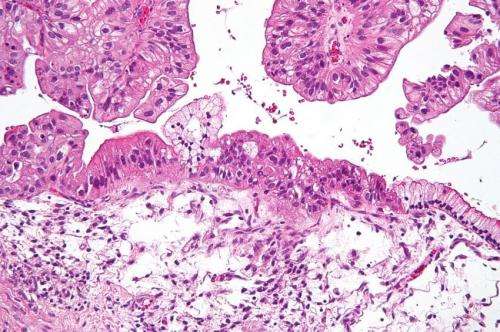This article has been reviewed according to Science X's editorial process and policies. Editors have highlighted the following attributes while ensuring the content's credibility:
fact-checked
peer-reviewed publication
trusted source
proofread
Experimental ovarian cancer diagnostic could lead to new precision oncology approach

Despite advances in surgery and chemotherapy, survival of people with certain types of ovarian cancer has not significantly changed in decades. That has meant that some ovarian cancer patients go through treatments that don't work, since it's not clear before treatment which tumors will respond.
A new study published Aug. 3 in Cell and led by scientists at Fred Hutchinson Cancer Center and the Winthrop P. Rockefeller Cancer Institute points the way toward a potential diagnostic that, once adapted for the clinic, could identify patients with types of ovarian cancers that would be refractory, or not responsive to standard treatments.
"We now have a potential 64-protein predictor that identifies up front—before they get treatment—about 35% of patients with refractory disease at a very high specificity," said Amanda Paulovich, MD, Ph.D., a Fred Hutch physician-scientist who holds the Aven Foundation Endowed Chair. "If we can identify patients who are unlikely to response to standard treatment, clinicians could help them pursue a clinical trial instead."
Paulovich and her collaborators focused on a subtype of epithelial ovarian cancer, called high-grade serous ovarian cancer, which accounts for the most deaths from ovarian cancer and for which treatments have not improved survival in decades.
"Right now, we can't identify these ovarian cancer patients up front. We find them by default: They get sick and pass away so quickly that they can't even be put on new clinical trials," said co-senior author Michael Birrer, MD, Ph.D., who directs the Winthrop J. Rockefeller Cancer Institute at the University of Arkansas for Medical Sciences. "This study is a huge step forward in that."
"These tumors have a complex phenotype, so there's no one single biomarker that distinguishes them and identifies which treatment they'll respond to," Paulovich said. "Most diagnostics that exist today are built around one biomarker, but for a complex situation like ovarian cancer treatment response, we need a multiplex diagnostic."
Paulovich has built her Fred Hutch lab around developing assays that can measure thousands of proteins and genetic markers in tumors, a field called proteogenomics. She and her research team use mass spectrometry and computational approaches to discern patterns in large numbers of proteins and genes, which could distinguish patient tumors and how they would respond to treatment.
In the Cell study, Paulovich and her collaborators characterized proteins and genetic markers in 242 high-grade serous ovarian cancers that responded or did not respond to treatment. The tumor samples were collected from patients before they began treatment.
In addition to discovering the 64 proteins that best signified tumors that would resist standard initial treatment with platinum-based chemotherapy, the team identified five different types of high-grade ovarian tumors that seem to be driven by different biological processes. The molecular changes at play in these newly defined ovarian tumor subtypes may well hold clues for scientists seeking targets for future targeted treatments and bring new treatment options for patients with chemotherapy-refractory disease.
Paulovich, an oncologist who treated breast cancer patients before pursuing a research career, is passionate about improving cancer diagnostics.
"I know from my own experiences caring for cancer patients that they have highly variable responses to the same cancer therapies, where one patient's tumor will shrink and another's won't change," Paulovich said. "My goal is to better predict how tumors will respond before patients undergo treatment so they don't have to waste their time on treatments that won't work and so that we can identify treatments that will work."
More information: Amanda G. Paulovich, Proteogenomic analysis of chemo-refractory high grade serous ovarian cancer, Cell (2023). DOI: 10.1016/j.cell.2023.07.004. www.cell.com/cell/fulltext/S0092-8674(23)00737-7




















